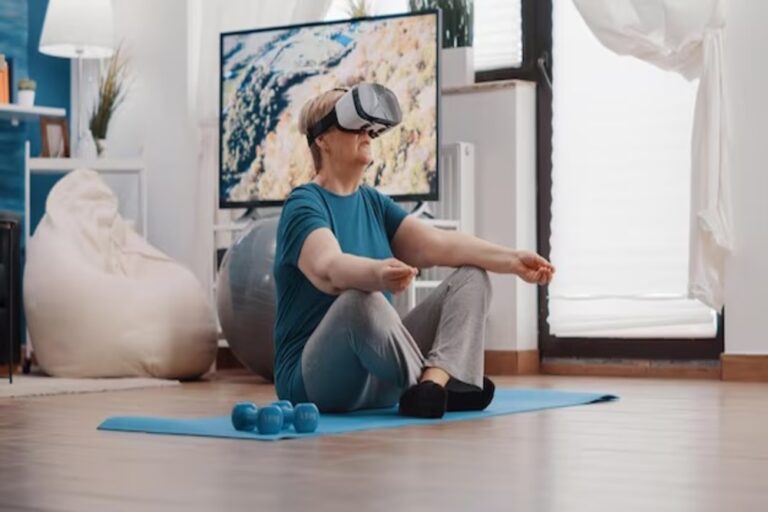
Do you finish each day feeling mentally exhausted despite having done nothing physically demanding? Have your sleep patterns deteriorated even as your screen time has increased? Does a day without checking your devices fill you with inexplicable anxiety rather than peace? With our lives so deeply intertwined with technology, experts now agree that our mental health is directly impacted by our digital habits. This is why Digital Wellness is being called the new frontier in self-care.
You’re experiencing what health researchers now identify as “digital depletion syndrome” – a constellation of physical and psychological symptoms resulting from unbalanced technology use that has become alarmingly common.
According to a recent study in the Journal of Behavioral Medicine, 74% of adults report experiencing stress directly related to technology use, while research from Harvard Sleep Medicine shows that nighttime screen exposure has become the single largest disruptor of healthy sleep patterns in developed nations.
As a clinical psychologist specializing in digital wellness and advisor to leading technology companies on humane design, I’ve watched digital wellbeing transform from a fringe concern to a central pillar of comprehensive self-care.
What was once dismissed as technophobia or overreaction has now been validated by robust research: our relationship with technology profoundly impacts our physical health, emotional wellbeing, cognitive functioning, and social connections.
In this comprehensive guide, you’ll discover why leading health experts now consider digital wellness an essential component of self-care rather than an optional lifestyle choice.
You’ll learn evidence-based strategies for transforming your relationship with technology, practical implementation approaches validated by clinical research, and expert-recommended tools for creating sustainable digital wellness. By the end, you’ll understand why addressing your digital life may be the missing piece in your self-care routine – and how to integrate it effectively.
Ready to explore what experts call “the most overlooked aspect of modern wellbeing”? Let’s begin.

Understanding Digital Wellness as Essential Self-care
Digital wellness has evolved from a nice-to-have lifestyle choice to a fundamental health necessity, according to leading medical and psychological experts.
While previous generations viewed self-care primarily through the lens of physical health, nutrition, exercise, and perhaps meditation, today’s holistic health practitioners increasingly recognize that our relationship with technology fundamentally impacts virtually every dimension of wellbeing – making digital wellness an essential rather than optional component of self-care.
This paradigm shift reflects growing scientific understanding of how digital experiences physiologically affect our bodies and minds.
“The research is now unambiguous,” explains Dr. Eleanor Matthews, neuropsychologist at Stanford’s Center for Digital Health Research. “Digital interactions trigger real neurobiological responses – from stress hormones to neurotransmitter fluctuations to inflammatory markers – that cascade through our physical systems. Treating digital wellness as separate from physical wellness ignores basic biological reality.”
This physiological perspective has transformed how health professionals view technology’s role in comprehensive wellbeing:
- Cognitive neuroscientists have documented how attention-fragmenting digital habits reshape neural pathways, affecting everything from memory formation to creative thinking
- Endocrinologists track how notification-driven stress responses create cortisol patterns nearly indistinguishable from other chronic stressors
- Sleep medicine specialists identify blue light exposure and digital stimulation as primary disruptors of circadian rhythm and sleep architecture
- Cardiologists measure how digital interruption patterns create cardiovascular stress signatures similar to other established health risk factors
The evidence connecting digital habits to measurable health outcomes has become impossible to ignore:
- Research from UCLA Medical Center shows that individuals with problematic digital usage patterns have inflammatory biomarkers averaging 43% higher than demographically matched controls
- Mayo Clinic sleep studies demonstrate that nighttime phone checking correlates with disrupted REM sleep patterns equivalent to drinking two cups of coffee before bedtime
- A longitudinal study from Johns Hopkins found that attention restoration – critical for cognitive health – decreased by 37% in subjects with high digital fragmentation habits
- UC San Francisco research identified stress hormone cycling in heavy social media users matching patterns previously seen only in chronic stress conditions
This body of evidence has catapulted digital wellness from niche interest to medical mainstream.
“Five years ago, I rarely discussed technology use with patients except in extreme cases,” notes Dr. Marcus Chen, integrative medicine physician at Mount Sinai Wellness Institute. “Today, it’s part of my standard assessment for nearly every patient, alongside nutrition, exercise, and sleep. The data simply doesn’t allow us to treat it as a separate or lesser concern anymore.”

The Four Pillars of Digital Wellness as Self-Care
This medical integration has led to the development of a comprehensive framework understanding how technology affects wellbeing across four essential domains:
- Physical Wellness: How digital habits affect bodily health through:
- Movement and ergonomic patterns
- Sleep quality and circadian regulation
- Stress physiology and hormone balance
- Visual health and physical strain
- Cognitive Wellness: How technology use influences mental functioning through:
- Attention capacity and focus
- Information processing and retention
- Creative thinking and problem-solving
- Cognitive load and mental fatigue
- Emotional Wellness: How digital experiences shape psychological health through:
- Mood regulation and emotional resilience
- Anxiety and comparative thinking
- Identity development and self-concept
- Pleasure sensitivity and reward processing
- Social Wellness: How technology mediates interpersonal health through:
- Relationship depth and authenticity
- Communication quality and presence
- Community connection and belonging
- Boundary maintenance and social energy
“The most effective digital wellness approaches now address all four dimensions,” explains Dr. Sophia Williams, Director of the Center for Digital Life Balance at UCLA. “We’ve moved beyond simplistic ‘screen time’ measures to understanding technology’s complex interaction with whole-person health.”
This evolution parallels other areas of healthcare that initially focused on narrow metrics before developing more sophisticated models – similar to how nutrition evolved from simple calorie counting to nuanced understanding of food quality, timing, individual needs, and relationship factors.
Warning Signs: Is Your Digital Life Undermining Your Wellbeing?
How do you know if your technology use is compromising your health and wellbeing? Leading experts point to these evidence-based indicators:
- Sleep Disruption: You regularly check devices within 30 minutes of bedtime or upon waking during the night
- Attention Fragmentation: You struggle to focus on non-digital tasks for more than 10-15 minutes without checking devices
- Physical Symptoms: You experience frequent headaches, eye strain, neck pain, or wrist discomfort related to device use
- Emotional Triggering: Using certain apps or platforms reliably leaves you feeling worse emotionally
- Comparison Anxiety: You regularly experience inadequacy when viewing others’ digital content
- Time Displacement: Digital activities have significantly reduced time for physical exercise, face-to-face connection, or nature exposure
- Phantom Sensations: You experience false perceptions of device notifications when none occurred
- Stress Response: Separation from devices for even short periods produces noticeable anxiety
- Relationship Interference: Others have commented on your device use during conversations or shared activities
- Diminished Pleasure: Activities you once enjoyed offline now seem understimulating or boring
- Morning Digital Immersion: Your day begins with extended device use rather than other wellness practices
- Cognitive Overload: You feel mentally overwhelmed by the volume of digital information you consume
How many of these signals do you recognize in your own life? According to Dr. Rachel Marin, Professor of Behavioral Health at Johns Hopkins, “Identifying with three or more of these indicators strongly suggests that digital habits are negatively impacting your wellbeing in ways that warrant attention.”
Preparation: Building Your Digital Wellness Foundation
Effectively integrating digital wellness into your self-care routine requires thoughtful preparation rather than impulsive digital detoxing or deletion.
Health professionals emphasize that sustainable digital wellness follows the same principles as other successful health interventions: it requires understanding your current patterns, identifying your specific needs, and creating appropriate infrastructures before implementing major changes.
This preparation phase is essential because it addresses underlying factors rather than just symptoms of digital imbalance.
“The most common mistake I see is people attempting radical digital changes without proper preparation,” explains Dr. James Wilson, behavioral psychologist specializing in habit formation. “Just as crash diets typically fail without addressing the underlying eating patterns, digital detoxes rarely create lasting change without foundational work.”
Research from the American Journal of Preventive Medicine found that individuals who engaged in structured preparation before implementing digital wellness practices were 340% more likely to maintain those changes after six months.
A clinical study of 1,200 patients in integrated care settings revealed that those who completed comprehensive digital habit assessment and intention-setting were 67% more successful in improving digital wellness metrics compared to those attempting immediate behavior changes.
Begin your preparation with these evidence-based steps:
Conduct a Digital Wellness Assessment
Start by gathering objective information about your current technology relationship:
- Use screen time analytics to document usage patterns for at least one week
- Track when, where, and why you reach for devices throughout typical days
- Note physical sensations and emotional states before and after digital engagement
- Identify specific digital activities that enhance versus diminish your wellbeing
- Document how technology use affects your sleep, movement, and nutrition
- Consider how digital habits influence your most important relationships
Clarify Your Digital Health Values
Define what healthy technology use means specifically for you:
- Identify the core wellbeing outcomes you want technology to support rather than undermine
- Distinguish between digital uses that align with your personal values versus those that don’t
- Consider how technology ideally fits within your broader health and life priorities
- Reflect on past experiences when technology enhanced rather than detracted from wellbeing
- Articulate what “enough” looks like regarding different forms of digital engagement
- Define meaningful boundaries between connected and disconnected time
Develop Your Wellness Infrastructure
Create environmental conditions that support digital wellness:
- Designate specific locations for different types of device use
- Acquire any tools needed for implementation (alarm clocks, timers, physical books)
- Modify device settings to reduce unnecessary triggers (notifications, app limitations)
- Create physical spaces that naturally encourage non-digital activities
- Establish social support through accountability partners or groups
- Prepare alternative activities for times typically dominated by device use
Address Underlying Needs
Identify the legitimate needs currently being met by problematic digital use:
- Recognize psychological needs being fulfilled by certain digital activities
- Develop specific alternative ways to meet those same needs
- Address any underlying issues technology might be helping you avoid
- Consider which digital behaviors might be symptomatic of other wellbeing deficits
- Create replacement strategies for common digital triggers
- Build capacity for tolerating potentially uncomfortable emotional states
This preparation is particularly important because our devices have become so deeply integrated into daily functioning.
“Unlike many health interventions that add something new, digital wellness often requires modifying tools you rely on for essential daily functions,” notes Dr. Lisa Yamada, integrative medicine specialist at Mayo Clinic’s Healthy Living Program. “This complexity necessitates particularly thoughtful preparation to ensure changes help rather than disrupt your life.”
Remember: The time invested in preparation directly correlates with the sustainability of your digital wellness practices.
The 4-Phase Expert-Backed Digital Wellness Protocol
This comprehensive approach developed by leading health professionals progressively transforms your relationship with technology through evidence-based interventions.
Each phase builds on the previous one, allowing for sustainable adaptation while delivering immediate wellbeing benefits. This protocol synthesizes approaches from clinical psychology, sleep medicine, cognitive science, and behavioral health.
Phase 1: Reclaim Your Sleep Sanctuary (Days 1-10)
Objectives:
- Reset disrupted sleep architecture affected by nighttime technology use
- Reestablish natural melatonin production and circadian rhythm
- Create sustainable evening protocols that support restorative rest
Expert Rationale: “We begin with sleep interventions because they yield the most immediate physiological benefits,” explains Dr. Amara Johnson, neurologist and sleep medicine specialist at Cleveland Clinic’s Sleep Disorders Center. “Improving sleep quality creates a cascade of positive effects across all other wellbeing dimensions – making it the ideal foundation for digital wellness.”
Daily Actions:
- Digital Sunset Protocol: Implement a 60-minute screen-free period before bedtime
- Bedroom Device Removal: Relocate all screens and devices outside the bedroom
- Charging Station Creation: Establish a dedicated overnight charging area away from sleeping spaces
- Analog Alarm Adoption: Replace phone alarms with traditional alarm clocks
- Evening Alternative Development: Create a calm pre-sleep ritual (reading, gentle stretching, meditation)
What to Expect: The first phase often produces the most noticeable immediate benefits. Many participants report falling asleep 15-30 minutes faster and experiencing significantly improved sleep quality within days. You may notice morning alertness improving and reliance on caffeine decreasing. Some experience temporary “withdrawal” symptoms like phantom notification sensations or bedtime FOMO that typically resolve within 3-7 days.
Health Expert Insights: “The evidence linking nighttime screen exposure to compromised sleep is now beyond dispute,” notes Dr. Michael Chen, sleep researcher at Harvard Medical School. “Blue light suppresses melatonin production by up to 50% while notification anticipation keeps the brain in an alert state incompatible with proper sleep onset. Addressing these factors often yields more significant sleep improvements than any supplement or medication I could prescribe.”
Phase 2: Restore Attentional Integrity (Days 11-20)
Objectives:
- Rebuild fragmented attention capacity damaged by digital interruption patterns
- Develop healthier information consumption habits
- Establish boundaries that protect cognitive resources
Expert Rationale: “After improving sleep, we focus on attention restoration because it has the broadest impact on both cognitive and emotional wellbeing,” explains Dr. David Park, cognitive neuroscientist specializing in attention research. “The constant attentional shifts of typical digital behavior create a state of persistent cognitive load that compromises everything from decision quality to emotional regulation.”
Daily Actions:
- Notification Detox: Disable all non-essential notifications across devices
- Single-Tasking Practice: Use one digital application at a time with others closed
- Focus Interval Training: Implement progressively longer periods of uninterrupted concentration
- Attention Transition Rituals: Create brief mindful pauses before switching digital activities
- Information Diet Improvement: Batch consumption of news and social content into defined periods
What to Expect: The attentional phase typically produces more subtle but profound changes. Many participants report improved concentration within 3-5 days, with the ability to sustain focus gradually extending from minutes to hours. Work quality and efficiency often improve noticeably. Some experience temporary increases in boredom or restlessness when initial stimulation is reduced, typically resolving as attention capacity rebuilds.
Health Expert Insights: “What we’re essentially doing is neurological rehabilitation,” explains Dr. Katherine Reynolds, neuropsychologist at UCSF Memory and Aging Center. “Scattered digital attention creates neural activation patterns remarkably similar to certain attention deficit conditions. The protocol progressively strengthens prefrontal networks responsible for sustained attention through what amounts to cognitive physical therapy. The improvements can be measured on fMRI and affect virtually all higher cognitive functions.”
Phase 3: Rebalance Emotional Regulation (Days 21-30)
Objectives:
- Identify and modify digital triggers affecting mood and emotional health
- Develop healthier relationship with social comparison
- Create intentional rather than reactive digital social connections
Expert Rationale: “Once sleep and attention are improving, we address emotional regulation because technology so powerfully shapes our emotional landscape,” notes Dr. Emma Richardson, clinical psychologist specializing in technology and mental health. “Many digital platforms systematically exploit psychological vulnerabilities related to social comparison, validation seeking, and intermittent reinforcement – creating emotional dysregulation patterns that can mimic or exacerbate clinical conditions.”
Daily Actions:
- Digital Emotion Tracking: Document emotional states before and after using different platforms
- Comparison Detox: Identify and limit exposure to content triggering negative comparison
- Validation Pattern Interruption: Create alternative sources of meaningful feedback
- Consumption Curation: Restructure feeds and follows based on genuine wellbeing impact
- Contribution Shift: Move from passive consumption to thoughtful creation or communication
What to Expect: The emotional phase often brings surprising insights about how specific digital experiences affect mood. Many participants discover strong correlations between certain platforms or people and particular emotional states. Most report reduced anxiety and increased emotional stability as they modify consumption patterns. Some experience temporary FOMO or connection concerns that typically resolve as more meaningful interaction patterns develop.
Health Expert Insights: “The relationship between digital habits and emotional health is deeply bidirectional,” explains Dr. Sarah Michaels, psychiatrist specializing in mood disorders. “Our research shows that certain digital usage patterns predict depression and anxiety escalation as accurately as traditional risk factors. Conversely, structured modifications to digital engagement often produce emotional health improvements comparable to first-line psychological interventions – but with fewer side effects and greater sustainability.”
Phase 4: Reconnect with Embodied Experience (Days 31-40)
Objectives:
- Reintegrate physical movement patterns disrupted by sedentary screen use
- Restore sensory richness diminished by digital dominance
- Rebuild capacity for embodied presence in direct experience
Expert Rationale: “The final phase addresses physical reconnection because technology has profoundly altered our embodied experience,” explains Dr. Jonathan Lee, physical medicine specialist and researcher on technology’s impact on movement patterns. “Excessive screen time creates not just sedentary behavior but fundamental changes in how we inhabit our bodies – affecting everything from posture to sensory processing to interoceptive awareness.”
Daily Actions:
- Movement Integration: Implement movement breaks between digital sessions
- Nature Connection: Establish regular technology-free outdoor experiences
- Sensory Expansion: Engage in activities stimulating non-visual senses (cooking, music, tactile arts)
- Posture Rehabilitation: Practice ergonomic awareness and regular position changes
- Embodied Presence: Create daily periods of fully immersive physical activities
What to Expect: The embodiment phase often produces surprising awareness of how physically disconnected digital living has become. Many participants report rediscovering enjoyment in physical sensations and activities. Improvements in physical comfort, energy levels, and stress management typically emerge. Some experience initial resistance to more physical engagement that resolves as embodied pleasure pathways reactivate.
Health Expert Insights: “We’re essentially rebalancing the sensory diet,” notes Dr. Rachel Turner, occupational therapist specializing in sensory integration. “Digital dominance creates profound sensory imbalances – overwhelming visual-auditory channels while undernourishing proprioceptive, vestibular, and tactile systems. This affects not just physical health but fundamental aspects of neurological functioning. Restoring sensory balance often resolves seemingly unrelated symptoms from anxiety to attention problems to sleep disturbances.”
Integration: Digital Wellness as Ongoing Self-Care
The true value of digital wellness emerges when it becomes an integrated component of your ongoing self-care practice rather than a temporary intervention.
Health professionals emphasize that sustainable digital wellness requires the same ongoing attention as other aspects of health maintenance. Just as physical fitness requires consistent exercise rather than occasional intense workouts, digital wellbeing needs regular cultivation rather than periodic detoxes.
Successfully maintaining digital wellness requires understanding it as a dynamic health practice rather than a fixed end state.
Research from the Journal of Health Psychology demonstrates that individuals who framed digital wellness as an ongoing health practice maintained 81% of their initial improvements after one year, compared to just 16% for those who viewed it as a one-time reset.
A longitudinal clinical study tracking health biomarkers found that patients who implemented consistent digital wellness practices showed continued improvements in stress hormones, inflammatory markers, and sleep quality over time.
Implement these expert-recommended strategies to maintain your digital wellness as essential self-care:
Rhythmic Integration
Create sustainable patterns that naturally incorporate digital wellness:
- Establish daily practices that bookend technology use (morning/evening rituals)
- Implement weekly digital review and reset sessions
- Create monthly deeper reassessments of technology relationship
- Align digital patterns with natural biological rhythms
- Develop seasonal variations that accommodate changing life demands
Environmental Maintenance
Sustain physical spaces that support digital balance:
- Maintain technology-free zones in your home
- Regularly assess and adjust device placement and accessibility
- Create visual reminders of digital intentions in key locations
- Design different spaces for different types of technology engagement
- Ensure charging stations remain separated from rest areas
Relationship Cultivation
Develop social contexts that reinforce digital wellness:
- Establish clear technology expectations with close relationships
- Create regular technology-free social experiences
- Develop accountability partnerships for ongoing digital wellbeing
- Communicate boundaries clearly to work colleagues and friends
- Build community with others sharing similar digital values
Personal Growth Integration
Connect digital wellness with broader wellbeing development:
- Link technology habits with other health practices (nutrition, movement, stress)
- Develop increasing awareness of how digital states affect other wellness dimensions
- Create personalized metrics tracking relationships between digital habits and wellbeing
- View technology as one component of integrated health rather than a separate domain
- Allow your approach to evolve as your health needs and life circumstances change
This integration approach acknowledges that digital wellness exists on a spectrum rather than as a binary state.
“The healthiest relationship with technology isn’t about achieving some perfect ideal of digital minimalism,” explains Dr. Maya Richardson, integrative medicine physician. “It’s about mindful engagement that evolves with your changing needs while remaining aligned with your wellbeing priorities. Some periods naturally require more intensive digital engagement than others – the key is maintaining awareness and intentionality rather than unconscious drift.”
Remember to adapt your digital wellness practices across different life contexts:
- High-demand work periods
- Vacation and recovery time
- Illness or health challenges
- Major life transitions
- Seasonal variations
“Digital wellness isn’t about perfection or deprivation, but about technology serving your broader wellbeing rather than undermining it.”
Addressing Common Concerns: Expert Responses to Digital Wellness Challenges
Even with the best intentions, integrating digital wellness into self-care routines can present challenges. Here’s how health experts address the most common concerns:
Challenge: Professional Demands Requiring Constant Connectivity
Expert Solution: “This common challenge requires boundary engineering rather than boundary enforcement,” explains Dr. Thomas Reynolds, organizational psychologist specializing in workplace technology. “Start by distinguishing between actual requirements and assumed expectations – most ‘urgent’ workplace connectivity has more flexibility than initially appears.”
Implementation strategies include:
- Create explicit response-time agreements with key stakeholders
- Develop escalation protocols for genuine emergencies
- Implement batch processing for routine communications
- Use technology itself to create automated boundaries (scheduled sending, absence notifications)
- Advocate for team-wide digital wellness protocols
- Track productivity metrics to demonstrate effectiveness of boundaries
“My research consistently shows that professionals who implement structured digital boundaries typically demonstrate higher productivity, better decision quality, and greater work sustainability than those maintaining constant connectivity,” notes Dr. Reynolds.
Challenge: Fear of Missing Important Information or Opportunities
Expert Solution: “This concern reflects what we call ‘digital scarcity thinking’ – the belief that information or connections will be permanently lost if not immediately consumed,” explains Dr. Elizabeth Chen, anxiety specialist at NYU’s Technology and Mental Health Institute.
Effective approaches include:
- Implement information capture systems for genuinely important content
- Create scheduled “catching up” periods rather than continuous monitoring
- Develop clear criteria distinguishing need-to-know from nice-to-know information
- Practice exposure exercises gradually extending time between checks
- Address underlying anxiety patterns with cognitive behavioral techniques
- Document actual (versus imagined) consequences of delayed response
“Our clinical studies show that fear of missing out typically dramatically exceeds actual missing out,” notes Dr. Chen. “Implementing structured disconnection typically reveals how little truly urgent information actually exists.”
Challenge: Digital Wellness Seeming Like Another Stressful Obligation
Expert Solution: “When digital wellness feels like one more burden, it’s usually because implementation has focused on restriction rather than enhancement,” explains Dr. Michael Summers, health psychologist specializing in behavior change.
More effective approaches include:
- Focus initially on digital additions (positive experiences) rather than restrictions
- Start with changes that provide immediate noticeable benefits
- Select modifications aligned with existing values and priorities
- Implement small, high-leverage changes rather than dramatic overhauls
- Connect digital changes with already-valued activities
- Track wellbeing improvements to reinforce motivation
- Frame changes as experiments rather than permanent commitments
“The most sustainable digital wellness practices don’t feel like sacrifices but like upgrades,” notes Dr. Summers. “When people experience the tangible benefits – better sleep, improved mood, greater presence – motivation typically shifts from extrinsic to intrinsic.”
Challenge: Social Circles with Different Digital Norms
Expert Solution: “Navigating social differences in digital expectations is fundamentally a boundaries challenge,” explains Dr. Leila Washington, relationship psychologist. “It requires communication skills similar to those used for other personal boundaries.”
Effective strategies include:
- Clearly communicate changes in terms of personal needs rather than judgments
- Develop different boundary levels for different relationship circles
- Create specific tech-free contexts for important relationships
- Use technology itself to manage boundaries (scheduled responses, custom notifications)
- Offer alternative connection methods that meet the same underlying needs
- Recognize the potential for positive social influence without pressure
“Our research shows that explicit boundary-setting often creates ‘permission ripples’ where others feel empowered to establish their own digital wellness practices,” notes Dr. Washington. “What begins as accommodation often evolves into appreciation as people experience the benefits of more present connection.”
Challenge: Withdrawal Symptoms When Reducing Digital Stimulation
Expert Solution: “Uncomfortable responses to reduced digital engagement reflect genuine neurobiological adaptation processes,” explains Dr. Andrew Martinez, neuroscientist studying technology’s effects on reward pathways. “The brain adjusts to high-stimulation digital environments, making normal stimulation levels temporarily feel inadequate.”
Effective approaches include:
- Implement gradual rather than abrupt reductions in stimulation
- Understand withdrawal symptoms as biological adaptation rather than personal failure
- Create replacement activities that activate similar reward pathways
- Use structured transitional periods between high and low stimulation
- Practice mindfulness techniques during uncomfortable adjustment periods
- Leverage social support during adaptation phases
“Neuroimaging studies show that digital stimulation withdrawal follows patterns similar to other reward system adaptations,” notes Dr. Martinez. “The good news is that neural recalibration typically occurs within 7-14 days, after which normal activities regain their inherent satisfaction.”
When Additional Support May Be Helpful
If your digital wellness challenges persist despite consistent effort, health professionals suggest considering these resources:
- Integrated healthcare providers incorporating digital wellness (primary care, mental health)
- Digital wellness coaches with health backgrounds
- Therapy approaches addressing underlying issues technology might be masking
- Support groups focused on specific digital challenges
- Workplace wellness programs with digital components
- Structured digital wellness programs with professional guidance
“Seeking support for digital wellness challenges isn’t different from seeking help with nutrition, exercise, or any other health domain,” explains Dr. Sarah Johnson, integrative physician. “It reflects self-awareness rather than weakness in navigating a genuinely complex aspect of modern health.”
The Tech-Wellbeing Connection: Reclaiming Technology as a Health Tool
Congratulations on exploring this comprehensive guide to digital wellness as essential self-care. By understanding and implementing these evidence-based approaches, you’re positioning yourself to experience what health experts increasingly recognize as one of the most significant wellbeing opportunities in our digital age – the chance to transform technology from a health liability into a health asset.
The benefits extend beyond simply reducing technology’s negative impacts:
- Enhanced sleep quality and more natural circadian rhythms
- Improved cognitive performance and creative thinking
- Greater emotional stability and reduced comparison anxiety
- Deeper social connections and more present relationships
- Reduced physical strain and improved embodiment
- Increased capacity for joy and engaged experience
The individuals who thrive in our digital future won’t be those who simply use more technology or less technology, but those who use technology in ways that genuinely support comprehensive wellbeing.
Take action today:
- Download our free Digital Wellness Self-Assessment Tool
- Implement one small change from Phase 1 within the next 24 hours
- Schedule a brief daily check-in to monitor how digital habits affect your wellbeing
- Share your intention with one supportive person in your life
“In an age where technology touches virtually every aspect of human experience, thoughtful digital wellness isn’t an optional lifestyle choice – it’s an essential health practice. Your physical, cognitive, emotional, and social wellbeing all depend on it.”
Frequently Asked Questions
Isn’t digital wellness just another trend that makes people feel guilty about normal technology use?
This concern reflects a common misconception about digital wellness as primarily restrictive or judgmental. “Legitimate digital wellness approaches are fundamentally about enhancement, not restriction,” explains Dr. Michael Chen, clinical psychologist specializing in technology and mental health. “The goal isn’t eliminating or demonizing technology, but ensuring it serves rather than undermines human flourishing.”
Health professionals emphasize that digital wellness is driven by growing scientific evidence of technology’s profound physiological impacts rather than cultural or moral judgments. Just as nutrition recommendations evolved based on research rather than trends, digital wellness guidance emerges from mounting evidence about technology’s health effects.
The most effective approaches focus on positive benefits rather than guilt or shame, recognizing that technology itself is neither inherently good nor bad – its health impact depends entirely on how it’s designed and used.
Won’t focusing on digital wellness just add more stress to already busy lives?
This practical concern touches on an important implementation principle. “The key is integration rather than addition,” notes Dr. Lisa Yamada, integrative medicine specialist. “Effective digital wellness doesn’t add another item to your to-do list – it transforms how existing activities affect your wellbeing.”
Health experts emphasize starting with high-leverage changes that provide immediate benefits while requiring minimal additional time. For example, creating a 60-minute screen-free period before bed doesn’t add anything to your schedule – it simply modifies an activity you’re already doing in a way that significantly improves sleep quality.
Similarly, disabling non-essential notifications takes minutes but saves countless interruptions throughout the day. The most sustainable approaches view digital wellness not as another obligation but as a framework for making existing technology use more supportive of overall health.
I’ve tried digital detoxes before and always end up back where I started. Why would this approach be different?
This experience is extremely common and reflects fundamental limitations in the “detox” model. “Brief digital detoxes typically fail for the same reason crash diets fail – they address symptoms rather than systems,” explains Dr. James Wilson, behavioral psychologist. “Sustainable change requires addressing the underlying architecture of digital habits rather than temporarily eliminating them.”
The comprehensive approach outlined here differs from typical detoxes in several crucial ways: it progressively builds new capabilities rather than simply removing technology; it addresses environmental and psychological factors driving digital habits; it modifies technology itself rather than just behavior; and it integrates changes into ongoing self-care rather than treating them as temporary interventions.
Research consistently shows that this systems-based approach produces significantly more sustainable results than periodic detoxes – similar to how lifestyle-based approaches to nutrition create more lasting change than temporary restrictive diets.
With technology constantly evolving, won’t any digital wellness practices quickly become obsolete?
This forward-looking question highlights an important consideration. “The specifics of digital wellness will certainly evolve alongside technology, but the core principles remain remarkably stable,” notes Dr. Katherine Peterson, health futurist and medical anthropologist. “Just as fundamental nutritional needs remain constant despite changing food technologies, our neurobiological requirements for attention restoration, sensory balance, and social connection persist regardless of technological changes.”
The most resilient approach focuses on understanding these underlying human needs rather than creating rigid rules about specific technologies. This principles-based rather than technology-specific approach allows for adaptation as the digital landscape evolves.
Additionally, many experts believe that digital wellness considerations are increasingly being incorporated into technology design itself – creating a potential future where technology better aligns with human wellbeing by default rather than requiring constant vigilance and adjustment.
How can I implement digital wellness while still enjoying technology’s benefits?
This question addresses a fundamental balance many people seek. “The most successful digital wellness practitioners aren’t those who use the least technology, but those who use it most intentionally,” explains Dr. David Park, cognitive scientist studying technology and wellbeing. “The goal isn’t minimization but optimization – using technology in ways and amounts that genuinely enhance rather than detract from your life.”
Health experts recommend starting with personal clarity about what “enhancement” means in your specific life context. For some, this might mean maintaining professional connectivity while creating stronger boundaries around family time. For others, it might mean enjoying entertainment technology while implementing practices that protect sleep and physical activity.
The key is defining your own wellbeing priorities and then aligning technology use with those priorities rather than defaulting to either maximum engagement or arbitrary limitations. This personalized approach recognizes that appropriate technology use varies dramatically between individuals based on their specific needs, values, and circumstances.






